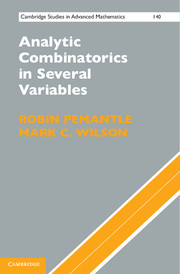Book contents
- Frontmatter
- Contents
- Preface
- PART I COMBINATORIAL ENUMERATION
- PART II MATHEMATICAL BACKGROUND
- PART III MULTIVARIATE ENUMERATION
- 8 Overview of Analytic Methods for Multivariate Generating Functions
- 9 Smooth Point Asymptotics
- 10 Multiple Point Asymptotics
- 11 Cone Point Asymptotics
- 12 Worked Examples
- 13 Extensions
- PART IV APPENDIXES
- References
- Author Index
- Subject Index
8 - Overview of Analytic Methods for Multivariate Generating Functions
Published online by Cambridge University Press: 05 July 2013
- Frontmatter
- Contents
- Preface
- PART I COMBINATORIAL ENUMERATION
- PART II MATHEMATICAL BACKGROUND
- PART III MULTIVARIATE ENUMERATION
- 8 Overview of Analytic Methods for Multivariate Generating Functions
- 9 Smooth Point Asymptotics
- 10 Multiple Point Asymptotics
- 11 Cone Point Asymptotics
- 12 Worked Examples
- 13 Extensions
- PART IV APPENDIXES
- References
- Author Index
- Subject Index
Summary
Part III returns to the problem at the heart of this book, namely how to make judicious choices of contours of integration to asymptotically evaluate the Cauchy integral (1.3.1). This may be summarized in one sentence as: push the chain of integration down to a critical point, then interpret the integral locally as an instance of a type i.e. classically understood. Depending on the geometry near the critical point, this step may take one of several forms. Each of the three chapters following this one details the process from start to finish in one of three cases, which together cover most known examples of rational generating functions. Extensions beyond this class are discussed briefly in Chapter 13.
These three chapters are self-contained, developing the theory in full rigor for the respective three cases. The present chapter is a complement, in which motivation and intuition are given for all the development in subsequent chapters. Its mission is to expand the six steps given at the end of Section 1.3 into a comprehensible program. In some cases we give heuristics without proof or give proofs that rely on Morse theory (included in Appendixes B and C). In one case, the heuristic relies on a conjecture not yet solved. Nevertheless, these heuristics provide firm guidance regarding how to accomplish the ensuing analyses. When these methods are fully developed in later chapters, only vestiges of the Morse-theoretic infrastructure remain.
Information
- Type
- Chapter
- Information
- Analytic Combinatorics in Several Variables , pp. 135 - 159Publisher: Cambridge University PressPrint publication year: 2013
